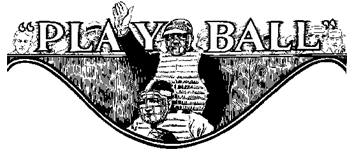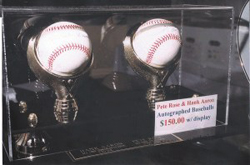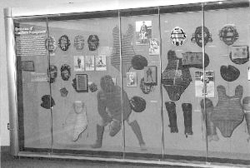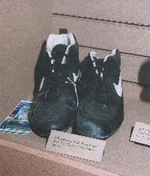|

|
|
Collecting
Baseball Memorabilia
A
Great American Pastime
Story
& Photos by Betsy Thigpen
|
|
|
 It's
Monday, July 27, 1998 Coopers town, New York.
The day after the Annual induction to the Baseball
Hall of Fame. The Baltimore Orioles and the
Toronto Blue Jays were playing a regular season
game there in Cooperstown. Fans found their
seats inside the stadium readying for the game.
Those without tickets gathered around Double
Day Field in the heart of Cooperstown to watch
the players arrive. Hands holding pieces of
paper, baseballs, bats, caps, anything hoping
for auto- graphs were outstretched from fans
young and old, male and female. The crowd grows
more intense when Cal Ripkin, third baseman
for the Orioles makes his way through the crowd.
While Cal is known in the memorabilia world
as one who doesn't normally attend shows, etc.,
he is very well known for spending extra time
with his fans before and after games. As he
made his way around the roped off area, signing
autographs along the way, it appeared one small
fan caught his eye. He kneeled down eye to eye
with Tom Whalen, a 7-year-old boy from New Britain,
Connecticut. Star struck, the young boy couldn't
answer Cat as he talked to him, signing his
baseball and card. Later, as the local news
stations honed in on the same incident, it appeared
as if Tom had been waiting for quite some time.
He was in the front of the crowd and was obviously
getting cramped by the over zealous fans. Perhaps
Cat noticed this and wanted to make the boy
feel like his efforts might have been worth
it. For whatever reason, the memory will never
leave the young man. As far as Tom and his family
are concerned, neither will the ball and card
Cat signed. Imagine, as Tom passes them down
to his children and grandchildren, what they
will be worth to a collector in those years
to come. It's
Monday, July 27, 1998 Coopers town, New York.
The day after the Annual induction to the Baseball
Hall of Fame. The Baltimore Orioles and the
Toronto Blue Jays were playing a regular season
game there in Cooperstown. Fans found their
seats inside the stadium readying for the game.
Those without tickets gathered around Double
Day Field in the heart of Cooperstown to watch
the players arrive. Hands holding pieces of
paper, baseballs, bats, caps, anything hoping
for auto- graphs were outstretched from fans
young and old, male and female. The crowd grows
more intense when Cal Ripkin, third baseman
for the Orioles makes his way through the crowd.
While Cal is known in the memorabilia world
as one who doesn't normally attend shows, etc.,
he is very well known for spending extra time
with his fans before and after games. As he
made his way around the roped off area, signing
autographs along the way, it appeared one small
fan caught his eye. He kneeled down eye to eye
with Tom Whalen, a 7-year-old boy from New Britain,
Connecticut. Star struck, the young boy couldn't
answer Cat as he talked to him, signing his
baseball and card. Later, as the local news
stations honed in on the same incident, it appeared
as if Tom had been waiting for quite some time.
He was in the front of the crowd and was obviously
getting cramped by the over zealous fans. Perhaps
Cat noticed this and wanted to make the boy
feel like his efforts might have been worth
it. For whatever reason, the memory will never
leave the young man. As far as Tom and his family
are concerned, neither will the ball and card
Cat signed. Imagine, as Tom passes them down
to his children and grandchildren, what they
will be worth to a collector in those years
to come.
For
most, it's the love of the game and the passion
of collecting things which mean something to
us that makes baseball memorabilia the multi-million
dollar business every year.
Fans
and collectors alike have been traveling to
Cooperstown, New York to visit the Baseball
Hall of Fame since its inception in 1939. The
town, nestled in the farmlands of mid New York
State, has grown with the influx of fans. Each
year, in July, some 40,000 fans converge upon
Cooperstown for the annual induction of new
'Hall of Famers.'
|

|
The
display of the Evolution of Catchers'
Equipment in the Baseball Hall of
Fame and Museum draws a lot of attention.
If these items were in Mint Condition,
their values would be astronomical.
|
Even
someone who's not an avid fan of the sport could
get caught in the excitement caused by the fans.
Walking among the other people on the streets
filled with 'baseball stores,' that feeling
of Mom, Apple Pie and the American Flag is overwhelming.
The
Baseball Hall of Fame and Museum are the epitome
to the sport. Everything from past World Series
rings to game worn jerseys, cleats, and equipment
don the walls of this prestigious sanctum of
the sport.
Among
the displays are lockers of Babe Ruth, Mickey
Mantle and Joe DiMaggio, larger than life showcases
depicting the careers of such greats as Ty Cobb
and Denton Young, visual chronicles of different
positions' equipment and uniforms as well as
'how the baseball and mitt are and have been
made. 'Memorabilia such as ticket stubs,
programs and various baseball cards accessorize
the larger displays.Murals of baseball parks
all over the country and wall size photos of
some of the best players from the sport surround
you at every corner. Not withstanding are the
histories of the different awards within the
sport and their recipients. For most fans, a
visit to the Hall of Fame and Museum is a life
long dream. An avid fan could spend hours searching
through everything and still want to look more.
Even
a person who isn't a fan of the sport or a collector
of the memorabilia could metamorphasize into
one just being in Cooperstown. The buzz of excitement
is in the air. Every shop is baseball oriented
and the memorabilia is overflowing. If it's
not here, they'll either find it or point you
in the direction of where you can find it.
Just
about anything in baseball can become collectors'
item. "Buy it because you like it,"
says Bob Pressley of BP Sports Collectibles
in Atlanta, Georgia. Bob's been in the business
in one form or another for over 15 years and
originally got in it because it was something
he enjoyed. As well as his shop which some would
say specializes more in the autographed collectibles,
Bob also promotes and holds three, two to three
day shows a year. Hosting between 70-80 dealer
booths, Bob characterizes his shows as "small
to medium in size." While most of the dealers
he'll have at a show are from the southeast,
he also draws dealers from Oklahoma, Kansas
and Illinois.
Bob's
'small to medium' show cannot be compared to
the recent 19th Annual Convention of Sports
Collectors Convention held in Chicago this past
summer which drew 1,000 dealer booths. The 20th
annual convention is slotted for Atlanta, Georgia.
People
collect everything from pins and pennants to
banks and balls while others concentrate on
autographed items - photographs, caps, balls,
bats, even hand written letters and cancelled
checks. It is reported that Jackie Robinson's
widow has recently released some cancelled checks
for availability to collectors.
Used
tickets as well as unused tickets are also collectible.
For example, tickets from the very first game
at the Atlanta Fulton County Stadium are probably
worth about $200, according to Pressley. Turner
Field "first" tickets might bring
between $75-$100 but a World Series ticket from
the 50's could bring up to $500.
Like
any other collection of anything, CONDITION
is the key to VALUE and baseball memorabilia
have a grading system much like you would find
in coin collections or anything else worth keeping.
Numbers from 1-10 (with 10 being the Bo Derek
best) are applied to most items; baseball cards
also have a 'grading' pricing guide. For example,
a game used bat wouldn't have the same criteria
as a bat purchased solely for display purposes.
A signed baseball is judged on the condition
on the ball and the quality of the signature.
Assuming the autograph is authentic, the way
in which it was signed is important also. Needless
to say, the scarcity of the item also affects
the price. For example, a baseball signed by
a player still in the league won't bring what
ball signed by a retired player would bring
or for that matter by a deceased player would
bring. "That's the morbid part of the hobby,"
says Pressley, "Once a player dies, especially
a Hall of Famer, the value of that piece goes
up."
Centering
on a baseball card is also crucial. While it
was more the 'luck of the draw' in the early
years of printing baseball cards, an educated
collector knows how to measure and rate the
centering of the cards. Centering refers to
the positioning the card was originally printed.
A card with more white space on the bottom and/or
sides than the top of the card is less desirable,
and worth less, than a card which has approximately
the same spacing on all sides.
|
An
example of different centering on
baseball cards. Notice the card
on the left depicts centering which
is way off (note difference of white
border on top as opposed to bottom)
compared to the Hank Aaron (borders
are more similar in width) on the
right. Neither is perfect, but it's
easier to see when put side-by-side.
|
Gamed
used equipment, autographed items and game used
autographed equipment seem to be what's hot
these days. Jerseys, uniforms, bats, gloves,
caps and even shoes are commanding premium prices.
For example a game used bat used by Cat Ripkin
might bring upwards of $2,000 while a display
bat autographed by Ripkin might only herald
$250.
Other
than dealers, how might someone come into possession
of game used equipment? Some of the teams will
hold auctions at the end of each season to sell
jerseys, etc. The Atlanta Braves, for example
held a silent auction the 23rd and 24th of August
offering game used uniforms and equipment with
the proceeds going to the Braves Foundation.
Of course, there are other ways to obtain game
used equipment but usually you have to "know
someone."
Auctions
are becoming very well known in the industry.
Reputable dealers as well as individuals participate
in silent auctions held all over the country.
Mastro Fine Auctions based in Chicago hold auctions
2-3 times a year. They'll send out catalogs
about 2 weeks before auction time (the last
one was 8 1/2 x11 and a little over an inch
thick). Collectors then can call in their bids
until closing of those bids. A 15% buyer's premium
is added to the total of the winning bid. Hundreds
sometimes thousands of items are offered for
every type of collector. Everything from pins
and banks to autographed baseballs and game
used equipment. Part of the July 17, 1998 auction,
an autographed Lou Gehrig baseball rated an
8 out of a possible 10 and advertised a minimum
bid of $5,000. The winning bid was $45,461!
A
minimum bid of $9,000 was listed on a 1959 Mickey
Mantle game worn jersey. This coveted jersey
brought $24,000.
Even
things one might not think would be as collectible
turn out to be. A ceramic Braves bank from the
late 40's sold at auction this past summer for
$1,814.
Other
than silent auctions, shows are always being
held all over the country. More often than not,
promoters, like Pressley, will contract players
to sign autographs at these shows as an additional
draw to the collector. "What used to cost
$100 to get an athlete (to a show)," says
Pressley, "now can cost $500-$1000. Muhammad
Ali, probably the most recognizable person in
the world, might cost $100,000. You'd probably
pay that for Joe DiMaggio also," he added.
"Some
ball players won't do shows," says Pressley.
"They would rather stay home with their
families." He added that a lot of the players
who won't do shows spend time before games,
etc., with their fans signing autographs. Pressley,
like other reputable dealers, will contract
players to come to his store, when it's closed,
to sign autographs.
|
These
spikes worn by 1995 World Series
MVP Tom Glavine of the Atlanta Braves
are among the many items displayed
at the Baseball Hall of Fame in
Cooperstown, NY. Imagine what these
"used shoes" would bring
to a collector.
|

|
Spring
training, traditionally a more casual atmosphere
for players, is a good place to obtain autographs,
says Pressley. Once into regular season, batting
practice (when the gates first open to the ballpark)
is another good time to try. "Once they
go into the locker room and get dressed, their
mind set changes," he added. "I've
also found players will sign for kids and women
before they will for men."
Beanie
BabiesTM have also infiltrated the Great American
Past time. Last year a Beanie BabyTM Cow was
given away honoring Harry Carey. When a Beanie
BabyTM is given this way, a registration card
is given with it stating, for example, it was
given in honor of Harry Carey, the date and
game it was given. "This particular Beanie
BabyTM with the registration card was selling
at the convention this year for $400,"
says Pressley. Congruently, Glory was handed
out at the All-Star Game and was selling at
the convention for $200. Chip the Cat, was handed
out at the Atlanta Braves game on August 10th
to the first 12,000 children (under 12) in honor:
of Andres Gallaraga. Wonder what this one will
bring at the 1999 convention.
A
year or so ago, one of the network nighttime
news shows ran a segment on baseball memorabilia.
To hear them talk, 80% of what's out there is
bogus; letters of authenticity aren't worth
any more than the paper on which they're written.
Not true, say Pressley and other reputable dealers
with whom this writer spoke. "If the dealer
is bogus to start with, his letter isn't going
be any good either." He provides his customers
with letters of authenticity however, but cautions
the item and the letter at some point might
become separated. The best advice Pressley and
others give - "Rely on a reputable dealer."
Bob
Pressley is in the business because it's what
he likes. He stays in the business because he
likes what he does. Likewise, he advises both
new and seasoned collectors, "Buy what
you like." Some collectors are in it because
of the love of baseball. Baby boomers seem to
comprise a large percentage of the collectors.
They say one of the reasons they collect baseball
memorabilia is it brings back good memories
of their youth. "If you're not a baseball
fan," says Pressley, "you can't relate
(to the enthusiasm)." It doesn't take thousands
upon thousands of dollars to collect baseball
memorabilia either. One can start with something
small and almost count on it appreciating in
value, if it's kept in good condition.
Whatever
the reason, baseball is as American as Mom and
Apple. Collectors of its memories are a part
of that American heritage and will remain so
for some time to come.
1999
|